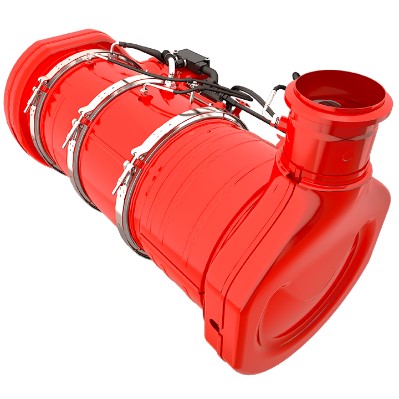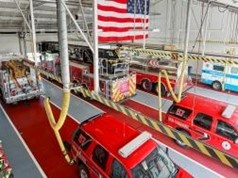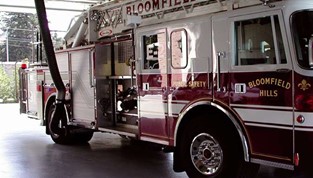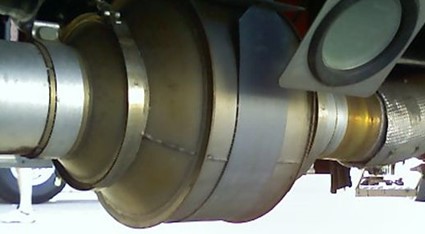FAMA BUYER’S GUIDE TC066 Supplemental Exhaust Emission Systems
Prepared by the FAMA Chassis Subcommittee
This guide does not endorse any manufacturer or product.

Contents
Introduction
This guide is intended to help fire service personnel understand current emissions systems installed on fire apparatus and discuss options for supplemental exhaust systems which may further reduce exhaust gas present during operation within the firehouse.
Overview
In the mid-1970s, the Clean Air Act began to regulate emissions from mobile and stationary sources. To meet more stringent exhaust emission standards mandated by this legislation, manufacturers invested in emissions reduction technology.
Gasoline engines began using two-way catalysts in 1975 to reduce carbon monoxide and hydrocarbon emissions. As a further improvement, three-way catalysts were introduced to reduce emissions of oxides of nitrogen.
Today’s diesel-powered apparatus also come equipped with an exhaust aftertreatment system. These diesel exhaust systems filter particulates from the exhaust gas and utilize catalysts to reduce hydrocarbons and oxides of nitrogen. Diesel engine manufacturers began installing Diesel Oxidation Catalysts and Diesel Particulate Filters in 2007 to reduce particulate emissions. In 2010, Selective Catalytic Reduction (SCR) Catalysts were implemented to remain compliant with lower acceptable levels of nitrogen oxides.
Supplemental exhaust systems are also available for the treatment or evacuation of exhaust gases from vehicles when in the fire station. This guide is designed as an educational piece that will help departments consider the options available.

Supplemental Diesel Exhaust Systems Options
Vehicle Mounted Capture Systems
These automatic systems are installed directly on the apparatus. They activate when the vehicle is started and continue filtering the exhaust while the truck is running. These systems are installed downstream from the manufacturer’s existing aftertreatment device before the diffuser tip.
The filter is constructed of a flow thru substrate with precious metal compounds that allow the system to regenerate when the ATD goes into regeneration mode.
Benefits of this system design include:
- No moving parts
- Vehicle mounted, no building modification is necessary
- Supplemental treatment continues outside of the building
- Can be placed on new vehicles or vehicles already in service
- Available for both horizontal and vertical exhaust systems
Disadvantages include:
Hose Evacuation Systems
These systems are installed in the station. A hose is connected to the tailpipe by a pneumatic or magnetic nozzle. When the vehicle is started an exhaust fan will automatically activate to evacuate the exhaust outside the building. An adjustable timer will keep the fan energized for a specified period of time. The hose travels along a slide track or rail system and is designed to disconnect when the vehicle has exited the station. After the hose disconnects, it will retract into its original storage position. Upon return to the station, the hose is manually attached as the apparatus enters the building.
Benefits of this system include:
- Not vehicle specific the system can be used for multiple vehicles
- Uses evacuation rather than treatment technology
- Can be used on vehicles of all vintages
Disadvantages include:
- May require building modifications
- Requires personnel to reconnect the hose when returning to be effective


Conclusion
Internal combustion engines give off hazardous fumes while running. FAMA recommends that you never run your apparatus engine inside a building unless the exhaust discharge is connected to an extraction system. Diesel engine exhaust and some of its constituents are known to the State of California to cause cancer,
congenital abnormalities, and other reproductive harm. Do not operate any internal combustion engine in an area where exhaust gases can accumulate, or serious injury or death may occur.
Consider your climate and how your apparatus are stored when determining how and whether to employ supplemental exhaust systems.


